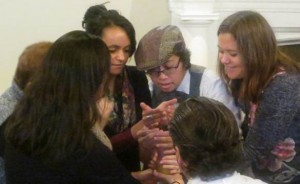
The Promise and Potential of Place-Based Leadership Programs
[This post was first published on NCRP’s blog] Photo courtesy of LeaderSpring.
By Cynthia A. Chavez
Editor’s Note: This piece is the third in a series featuring leadership development experts on the value they’ve found in NCRP’s new report,Cultivating Nonprofit Leadership: A (Missed?) Philanthropic Opportunity. For past posts, click here.
In the early 1990s, I had an inspiring mentor, Dr. Norm Brown, then-President of the W.K. Kellogg Foundation. Dr. Brown was a great believer in the value of nonprofit leadership development. He encouraged me to participate in a variety of such national programs. Dr. Brown also enthusiastically introduced me to the concept of place-based leadership development. His excitement was contagious: for 15 years now, I have been at the helm of LeaderSpring, an Oakland, California-based organization that explores the power and promise of leadership development within a place-based strategy.
Cultivating Nonprofit Leadership: A (Missed?) Philanthropic Opportunity, the new report from the National Committee for Responsive Philanthropy (NCRP), invites further exploration into the impacts of place-based leadership development strategies. The growing interest in place-based initiatives complements what we’ve realized for some time – that place-based approaches offer effective strategies to boost impact, especially in addressing issues like poverty. The field also has accumulated a critical mass of experience and informed insight on such initiatives. LeaderSpring’s 18 years of combining a place-based strategy with a peer-based cohort leadership development model yields some core reflections:
Place-based leadership development enables leaders to strengthen their competencies within their organization and community.
For individuals, place-based approaches weave leadership, management education and meaningful reflection into the fabric of their day-to-day work, leading to timely and relevant learning opportunities.
Place-based strategies, by both proximity and design, amplify the effect of leadership development by strengthening and aligning leadership throughout an organization.
LeaderSpring Fellows, for example, are accompanied by their board chairs in a full-day “Board Summit,” during which they formulate a shared vision, fixed strategies and actionable plans to strengthen their boards. As Judy Appel of Our Family Coalition reflects, “It was amazing to spend the full day with my board chair. … It opened his eyes to the potential of our board. The summit helped us see where to go next with the board, at a time when I really need their support.”
Aided by overlapping missions, constituencies and territories, place-based leadership development models can promote deep and sustained connections among leaders and their organizations.
As the NCRP report says, “Leadership development goes beyond the individual; it often can lead to collaborative leadership in cooperation or coalition with other leaders who share values or goals.” Every year, LeaderSpring awards two-year Fellowships to 15 nonprofit leaders within a 30-mile radius of one another. Monthly day-long “Leaders Circles” rotate among Fellows’ agencies, creating the conditions for cross-agency collaborations that leverage resources, integrate services, and have an exponential impact on the communities they serve.
Alumni of place-based leadership development programs have the potential to achieve powerful collective impact.
Our Alumni were eager to leverage our community to build upon its shared passion for, and expertise in, improving local outcomes to attain large-scale change. Last year, guided by volunteer members from our network of 200 graduates, we launched two pilot projects. To promote opportunities for movement building and collective action, a core group of Alumni, staff and stakeholders guided the transformation of our Alumni governance structure using the Community-Engagement Governance™ model. We also piloted the LeaderSpring Innovation Lab, which supports executive teams from six agencies run by Fellowship Alumni to experiment with creative ways to address persistent governance and leadership challenges. These efforts by our Alumni will provide important lessons to share with the wider social sector – and ultimately, have the potential to strengthen the nonprofit sector and transform the policy landscape.
Reading the NCRP report, I was intrigued as much by the commonalities among the leadership development programs profiled as by their rich diversity. I am struck by the degree to which nationally-focused and place-based programs can be complementary. For example, the Kellogg Foundation’s new Community Leadership Network Fellowship is a creative hybrid that combines place-based fellows and national fellows (an approach that I imagine would be met with great enthusiasm by Dr. Brown).
NCRP states that this country may be at a “movement moment” toward deepening democracy. We are fortunate to have a wealth of leadership development programs, place-based, national and beyond. Together, hundreds of individuals in the social sector across the country are strengthened by all types of leadership development programs. As we become increasingly aware of the potential to mobilize these leaders to work together on cross-cutting political, social and economic issues, we must ask ourselves:
- How might leader networks around the country galvanize their resources and constituencies toward increased advocacy, policy and systems change?
- What promising movement- and field-building opportunities might be catalyzed by greater collaboration across national and place-based leadership development efforts?
Dr. Brown, who sadly passed away in 2012, had an unwavering vision of a healthy and equitable world. A fundamental step toward making this vision a reality lies in locally galvanizing cross-issue and multi-cultural leaders and nonprofits toward a common equity agenda while partnering with national allies to achieve transformative policy change. This is but one of the promises and potential of place-based leadership programs to advance on this movement moment. To this end, Cultivating Nonprofit Leadership: A (Missed?) Philanthropic Opportunityoffers a valuable path forward for how funders can support this crucial strategy, along with similar and complimentary programs.
Cynthia A. Chavez is executive director of LeaderSpring((1)). Follow @LeaderSpring on Twitter and join the#CultivateNonprofitLeadership conversation.
((1))LeaderSpring is a TWI multi-year grantee.